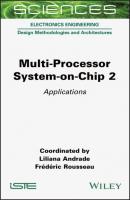Multi-Processor System-on-Chip 2. Liliana Andrade
Чтение книги онлайн.

Читать онлайн книгу Multi-Processor System-on-Chip 2 - Liliana Andrade страница
Название: Multi-Processor System-on-Chip 2
Автор: Liliana Andrade
Издательство: John Wiley & Sons Limited
Жанр: Зарубежная компьютерная литература
isbn: 9781119818403
isbn:
Table of Contents
1 Cover
4 Foreword
6 PART 1: MPSoC for Telecom 1 From Challenges to Hardware Requirements for Wireless Communications Reaching 6G 1.1. Introduction 1.2. Breadth of workloads 1.3. GFDM algorithm breakdown 1.4. Algorithm precision requirements and considerations 1.5. Implementation 1.6. Conclusion 1.7. Acknowledgments 1.8. References 2 Towards Tbit/s Wireless Communication Baseband Processing: When Shannon meets Moore 2.1. Introduction 2.2. Role of microelectronics 2.3. Towards 1 Tbit/s throughput decoders 2.4. Conclusion 2.5. Acknowledgments 2.6. References
7 PART 2: Application-specific MPSoC Architectures 3 Automation for Industry 4.0 by using Secure LoRaWAN Edge Gateways 3.1. Introduction 3.2. Security in IIoT 3.3. LoRaWAN security in IIoT 3.4. Threat model 3.5. Trusted boot chain with STM32MP1 3.6. LoRaWAN gateway with STM32MP1 3.7. Discussion and future scope 3.8. Acknowledgments 3.9. References 4 Accelerating Virtualized Distributed NVMe Storage in Hardware 4.1. Introduction 4.2. Motivation: NVMe storage for the cloud 4.3. Design 4.4. Implementation 4.5. Results 4.6. Conclusion 4.7. References 5 Modular and Open Platform for Future Automotive Computing Environment 5.1. Introduction 5.2. Outline of this approach 5.3. Results 5.4. Use case 5.5. Conclusion 5.6. References 6 Post-Moore Datacenter Server Architecture 6.1. Introduction 6.2. Background: today’s blades are from the desktops of the 1980s 6.3. Memory-centric server design 6.4. Data management accelerators 6.5. Integrated network controllers 6.6. References
8 PART 3: Architecture Examples and Tools for MPSoC 7 SESAM: A Comprehensive Framework for Cyber–Physical System Prototyping 7.1. Introduction 7.2. An overview of the SESAM platform 7.3. VPSim: fast and easy virtual prototyping 7.4. Hybrid prototyping 7.5. FMI for co-simulation 7.6. Conclusion 7.7. References 8 StaccatoLab: A Programming and Execution Model for Large-scale Dataflow Computing 8.1. Introduction 8.2. Static dataflow 8.3. Dynamic dataflow 8.4. Dataflow execution models 8.5. StaccatoLab 8.6. Large-scale dataflow computing? СКАЧАТЬ